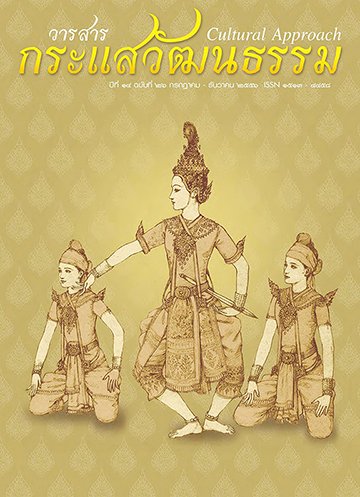วิถีชีวิตนักดนตรีตาบอดในสังคมไทย : กรณีศึกษา กรุงเทพมหานคร
Main Article Content
บทคัดย่อ
บทคัดย่อการวิจัยในครั้งนี้มีวัตถุประสงค์เพื่อศึกษาวิถีการดำเนินชีวิตของนักดนตรีตาบอดในสังคมไทย และเพื่อศึกษาการสร้างอัตลักษณ์ของนักดนตรีตาบอดในสังคมไทย เก็บข้อมูลจากกลุ่มตัวอย่างนักดนตรีตาบอดจำนวน9 คน พี่เลี้ยงนักดนตรี 3 คน ผู้ประกอบการในพื้นที่ใกล้เคียงกับการแสดง 3 คน และผู้บริจาค 6 คน โดยใช้วิธีการวิจัยเชิงคุณภาพ ด้วยวิธีวิทยาแบบชาติพันธุ์วรรณา (Ethnomethodology) วิธีการเก็บข้อมูลด้วยการสัมภาษณ์เชิงลึก (In-Dept Interview) การสนทนากลุ่ม (Focus Group) และการสังเกตแบบมีส่วนร่วม (ParticipateObservation)ผลวิจัยพบว่า นักดนตรีตาบอด มีครอบครัวโดยแต่งงานกับคนปกติ ภูมิลำเนาอยู่ต่างจังหวัด ระดับการศึกษาสูงสุดคือมัธยมศึกษาตอนต้น นักดนตรีคนตาบอดสามารถใช้ชีวิตประจำวันได้ใกล้เคียงกับคนปกตินอกจากการแสดงดนตรีแล้วอาชีพเสริมคือการค้าขาย โดยแสดงดนตรีในสถาบันการศึกษาเป็นหลัก รูปแบบการตั้งวงมีลักษณะความเป็นครอบครัว เครื่องดนตรีเป็นเครื่องดนตรีที่ใช้แล้ว กลยุทธ์ในการแสดงดนตรีคือการเลือกเพลงให้ตรงกับกลุ่มผู้ฟัง และเปิดโอกาสให้ผู้ฟังขอเพลงได้ การจัดสรรรายได้เมื่อหักค่าใช้จ่ายแล้วจะแบ่งเท่ากัน ปัญหาและอุปสรรคในการแสดงดนตรีคือ สภาพอากาศ สภาพเศรษฐกิจ การแยกวงเป็นศิลปินเดี่ยวมิจฉาชีพ และเจ้าหน้าที่เทศกิจนักดนตรีตาบอดได้สร้างอัตลักษณ์แห่งตนขึ้นมาผ่านความสามารถในการแสดงดนตรี เพื่อรื้อถอนวาทกรรมของสังคมที่มองว่าเป็นผู้ด้อยโอกาส แต่ถึงแม้ว่านักดนตรีตาบอดจะพยายามสร้างอัตลักษณ์ ความเป็นตัวตนให้สังคมทั่วไปประจักษ์ แต่วิถีชีวิตของพวกเขาก็จำเป็นที่จะยังคงอยู่ในโครงครอบของกฎเกณฑ์ในสังคมบางครั้งนักดนตรีตาบอดได้นำเอาสิ่งที่สังคมคาดหวังและนิยามความหมายให้กับพวกเขามาใช้สร้างอัตลักษณ์คำสำคัญ : วิถีชีวิต นักดนตรีตาบอด อัตลักษณ์
Article Details
รูปแบบการอ้างอิง
ปานยินดี ส. (2014). วิถีชีวิตนักดนตรีตาบอดในสังคมไทย : กรณีศึกษา กรุงเทพมหานคร. วารสารกระแสวัฒนธรรม, 14(26), 3–29. สืบค้น จาก https://so02.tci-thaijo.org/index.php/cultural_approach/article/view/15658
ประเภทบทความ
Research Article
Proposed Creative Commons Copyright Notices
1. Proposed Policy for Journals That Offer Open Access
Authors who publish with this journal agree to the following terms:
- Authors retain copyright and grant the journal right of first publication with the work simultaneously licensed under a Creative Commons Attribution License that allows others to share the work with an acknowledgement of the work's authorship and initial publication in this journal.
- Authors are able to enter into separate, additional contractual arrangements for the non-exclusive distribution of the journal's published version of the work (e.g., post it to an institutional repository or publish it in a book), with an acknowledgement of its initial publication in this journal.
- Authors are permitted and encouraged to post their work online (e.g., in institutional repositories or on their website) prior to and during the submission process, as it can lead to productive exchanges, as well as earlier and greater citation of published work (See The Effect of Open Access).
Proposed Policy for Journals That Offer Delayed Open Access
Authors who publish with this journal agree to the following terms:
- Authors retain copyright and grant the journal right of first publication, with the work [SPECIFY PERIOD OF TIME] after publication simultaneously licensed under a Creative Commons Attribution License that allows others to share the work with an acknowledgement of the work's authorship and initial publication in this journal.
- Authors are able to enter into separate, additional contractual arrangements for the non-exclusive distribution of the journal's published version of the work (e.g., post it to an institutional repository or publish it in a book), with an acknowledgement of its initial publication in this journal.
- Authors are permitted and encouraged to post their work online (e.g., in institutional repositories or on their website) prior to and during the submission process, as it can lead to productive exchanges, as well as earlier and greater citation of published work (See The Effect of Open Access).


